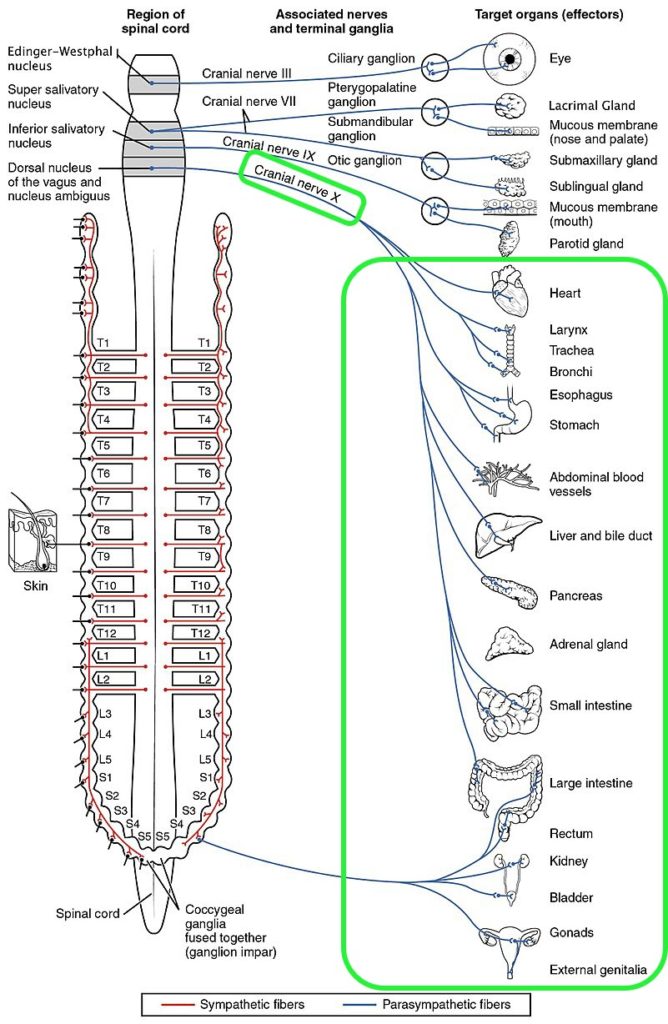The vagus nerve is part of our involuntary nervous system. All vertebrates have two nervous systems:
1) An arbitrary nervous system that, for example, controls our movements by controlling our muscles;
2) An involuntary or autonomic nervous system that operates independently of our conscious will. Many bodily functions are controlled beyond our will. This mainly concerns the bodily functions related to the survival and maintenance of the species: respiration, functioning of the heart and blood vessels, digestion, growth and reproduction.
Most involuntary bodily functions involve two opposing actions.
For example:
– Slowing down the heart rate, but also speeding it up;
– Circular muscles can tighten, but also relax;
– Blood vessels can widen, but also narrow.
Two nervous systems
Therefore, there is a duality of two systems in the autonomic nervous system: the orthosympathetic and the parasympathetic. The orthosympathetic system starts from the vital brain centres in the brainstem and runs through the spinal cord and nerve cords along the spinal cord to the muscles, skin and organs.
The parasympathetic system also departs from the brainstem but goes to our organs via the vagus nerve or tenth cranial nerve.

The two react in dialectical interaction, like yin and yang, to impulses, such as stress and threat. The orthosympathetic triggers a fight or flight response. When that system is stimulated, the heart rate increases, blood pressure increases and the concentration of sugars and fats in the blood, sources for direct energy use, increases. If the parasympathetic system is active, we will get an immobilizing reaction. For example, the intestinal tract will shut down to conserve maximum energy for the fight or flight response.
The reptiles also have an orthosympathetic and parasympathetic system. But in the evolutionary transition from reptiles to mammals 250 million years ago, a third system has also developed in mammals, fueled by a new anterior branch of the vagus nerve. A diaphragm formed, separating the upper body with the heart and lungs from the abdomen. Above that diaphragm, an anterior branch of the nerve of the vagus nerve developed
We measure how active this front branch of the vagus nerve is by its tension or tone: the vagal tone. When we inhale, the heart beats a little faster. That is logical: the inhaled air must exchange oxygen and CO2 at the height of the alveoli. Conversely, when we exhale, we show a slower heart rhythm.
There is empirical evidence that a stronger vagal tone is associated with a better feeling, more concentration, better stress tolerance, more prosocial feelings, less social inhibition and a higher degree of attachment in children.
The vagal tone also raises oxytocin levels or increases sensitivity to it.
You can strengthen the vagal tone through breathing exercises, meditation, mindfulness and Tai Chi.
The new understanding of this third nervous system, which is ignited by the vagus nerve, has shifted the classical view of the duality between the orthosympathetic and parasympathetic in the involuntary nervous system towards the image of a trio. The concept of a three-in-hand provides a substantially more differentiated and friendly picture of humanity.
Enough read for today, stop reading and start your Tai Chi exercises 😊
Freely taken from the book “De Super samenwerker” by Dirk van Duppen and Johan Hoebeke.

[…] vagus nerve, referred to as the wandering nerve in Latin, is one of the longest nerves and is a cranial nerve […]